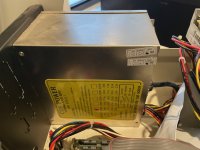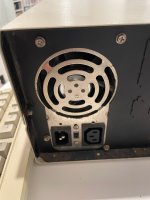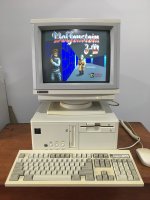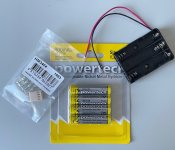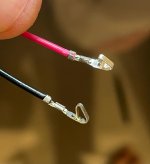Brad Cancian
Member
- Joined
- Apr 9, 2018
- Messages
- 18
Hi all - apologies if there's an easy answer somewhere, I am not very knowledgeable on these old computers!
I have my childhood 386 from December 1992 that up until a recent move of home was working fine. The adventure of moving house saw me have the computer in the back of my car over a 2,100km journey (approx 1,300 miles) here in Australia (well packed to as to avoid too much movement, noting that some bumps and vibrations would have been inevitable).
When putting the computer back together to get it working, the computer would not start. I think I have narrowed the issue down to the power supply. The power supply turns on the monitor, but the fan does not spin and there appears to be no power to any other part of the computer (including the hard drive, and thus presumably, the rest of the boards).
I can hear a slight electrical humming from the power supply, and I can see the fan move slightly when I try to turn the power on and back off, so it looks like it is trying to spin and turn over but is not able to do so.
Is the power supply kaput? Or is there something I can do to further fault find including pulling the power supply out and apart? Would something else be causing this? i.e. could this be a power supply that needs load to operate properly, and without this, it won't? I am curious if this might be the case given the power supply is moving the fan slightly on power up and also powering on the monitor?
This is the original power supply from December 1992.
Attached are some quick pictures of the power supply itself, so you can see the basic type (I can't see a specific make or model, so unsure of the details on what this actually is... again, apologies, I am certainly no expert here!).
If I do need to replace the power supply, where might I find an appropriate power supply these days?
Thanks all for your help!
Kindest regards,
Brad
I have my childhood 386 from December 1992 that up until a recent move of home was working fine. The adventure of moving house saw me have the computer in the back of my car over a 2,100km journey (approx 1,300 miles) here in Australia (well packed to as to avoid too much movement, noting that some bumps and vibrations would have been inevitable).
When putting the computer back together to get it working, the computer would not start. I think I have narrowed the issue down to the power supply. The power supply turns on the monitor, but the fan does not spin and there appears to be no power to any other part of the computer (including the hard drive, and thus presumably, the rest of the boards).
I can hear a slight electrical humming from the power supply, and I can see the fan move slightly when I try to turn the power on and back off, so it looks like it is trying to spin and turn over but is not able to do so.
Is the power supply kaput? Or is there something I can do to further fault find including pulling the power supply out and apart? Would something else be causing this? i.e. could this be a power supply that needs load to operate properly, and without this, it won't? I am curious if this might be the case given the power supply is moving the fan slightly on power up and also powering on the monitor?
This is the original power supply from December 1992.
Attached are some quick pictures of the power supply itself, so you can see the basic type (I can't see a specific make or model, so unsure of the details on what this actually is... again, apologies, I am certainly no expert here!).
If I do need to replace the power supply, where might I find an appropriate power supply these days?
Thanks all for your help!
Kindest regards,
Brad
Attachments
Last edited:

